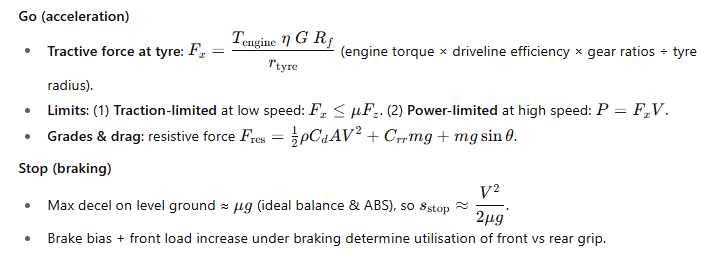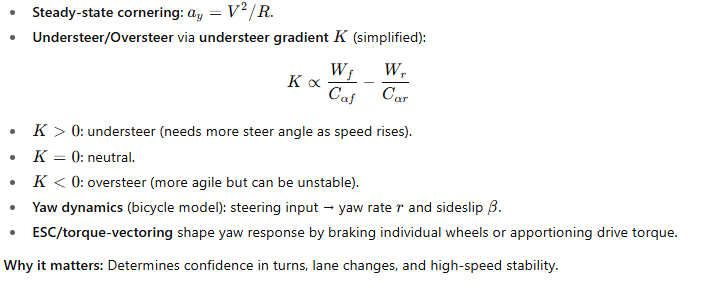Vehicle Dynamics is the study of how a vehicle moves and responds to forces acting on it. In simple terms, it’s the science of how a car behaves on the road under different conditions — accelerating, braking, cornering, or driving over bumps.
The basic principles of vehicle dynamics are:
- Newton’s Laws of Motion – vehicle motion is governed by force, mass, and acceleration.
- Kinematics & Kinetics – describing motion (speed, acceleration) and the forces causing it.
- Tire Dynamics – tire forces and slip control most of the vehicle’s behavior.
- Weight Transfer – load shifts between wheels during acceleration, braking, and cornering.
- Longitudinal Dynamics – acceleration, braking, and traction.
- Lateral Dynamics – cornering, handling, and stability.
- Vertical Dynamics – suspension effects, ride comfort, and vibration.
- Aerodynamics – drag, downforce, and stability at high speeds.
Newton’s Laws of Motion:
- Inertia: A car keeps its speed and direction unless a net force acts (engine/brakes/tyres/aero/grade).
- F = m*a: Acceleration comes from the net force on the car:
- Longitudinal: Fx=max (engine/brakes vs drag + rolling resistance).
- Lateral: Fy=may (cornering force from tyres).
- Action–reaction: Tyres push the road; the road pushes back with equal and opposite force—this road reaction is what accelerates, turns, and stops the car.
Why it matters: Every handling/braking/acceleration calculation ultimately reduces to “what forces can the tyres generate for a given mass?”
Kinematics & Kinetics:
- Kinematics: Describes motion only (no forces). Positions, velocities, accelerations, yaw/roll/pitch rates, path radius R with ay=V2/R.
- Kinetics: Adds forces/torques causing that motion—tyre forces, aero loads, gravity, suspension forces.
- Degrees of freedom: 6 total (surge/sway/heave + roll/pitch/yaw). Handling models (e.g., “bicycle model”) often track lateral velocity v, yaw rate r, and sideslip β
Why it matters: Kinematics tells what the car is doing; kinetics tells why—and is how we tune parts to change the motion.
Tire Dynamics:
Tyres are the only forces connecting car to road.
Key ideas
- Normal load Fz: Grip potential ≈ μFz (but load sensitive: doubling Fz< doubles grip).
- Longitudinal slip s: difference between wheel speed and road speed → braking/traction force curve (peaks around 10–20% slip on dry asphalt).
- Slip angle α: small angle between tyre’s pointing direction and actual travel; produces lateral force Fy.
- Cornering stiffness Cα: slope of Fy vs α near zero; bigger → crisper turn-in.
- Combined slip & friction circle/ellipse: longitudinal and lateral forces share the same grip “budget.” If ∣Fx∣ is large, max ∣Fy∣ drops.
- Camber thrust, aligning torque (Mz), relaxation length: govern feel and transient response.
- Influencers: compound, temperature, pressure, tread, road μ, vertical load, speed, camber, toe.
Why it matters: All acceleration/turning/stopping depends on how tyres create Fx, Fy from slips and loads.
Weight Transfer :
When the car accelerates, brakes, or corners, load shifts between tyres even though total weight W=mg is constant.
Longitudinal (front↔rear)

- hCG: CG height, L: wheelbase, ax: longitudinal accel (braking negative).
- Braking adds load to the front, traction/braking capacity changes accordingly.
Lateral (left↔right)

- t: track width, ay: lateral accel.
- Roll stiffness distribution (springs/ARB) decides how much transfer each axle takes.
Why it matters: Weight transfer changes each tyre’s Fz and therefore available grip; minimizing unnecessary transfer (lower hCG, wider t) improves total grip.
Longitudinal Dynamics :

Lateral Dynamics :

Vertical Dynamics :

Aerodynamics :

Summary:
Tyres provide forces; weight transfer and aero change how much they can provide.
Longitudinal/lateral/vertical dynamics describe the motions produced by those forces.
Kinetics ties it all back to Newton’s laws, and kinematics describes the resulting motion you measure and feel.
Other courses:



